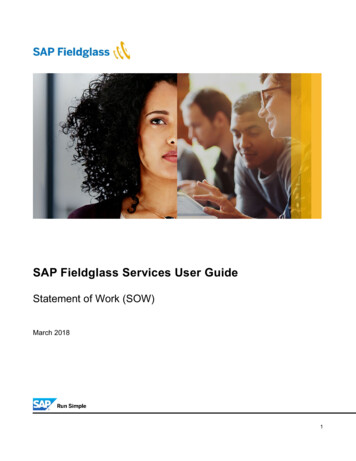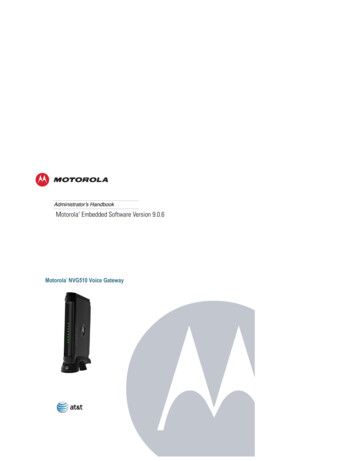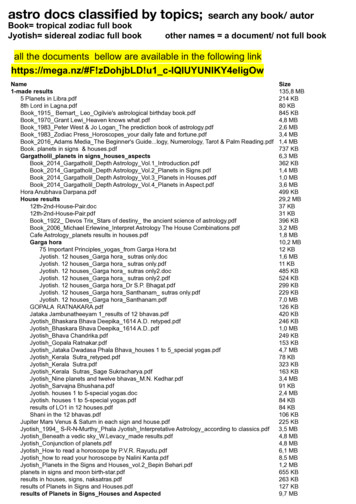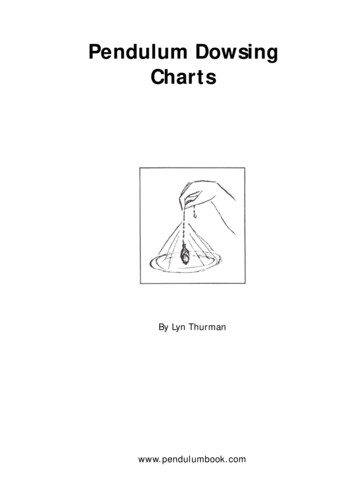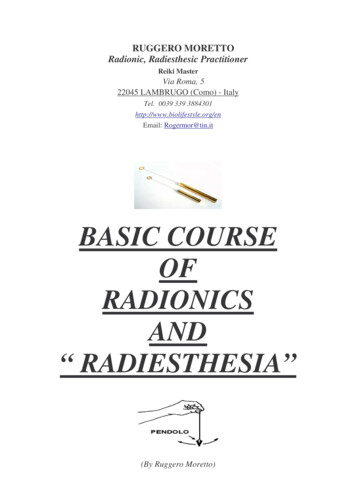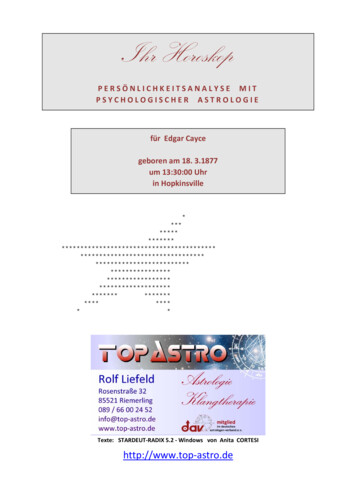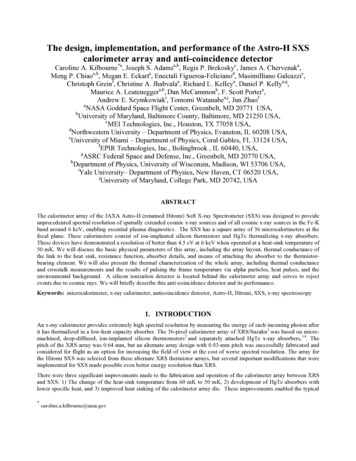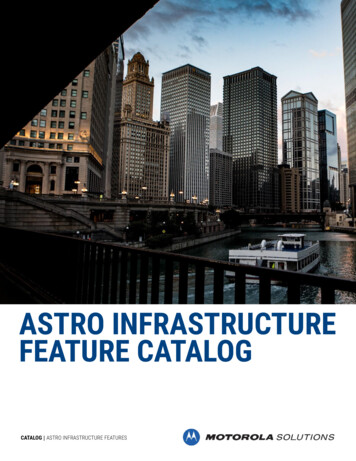
Transcription
ASTRO INFRASTRUCTUREFEATURE CATALOGCATALOG ASTRO INFRASTRUCTURE FEATURES
This catalog provides an overview of some of our most popular features available withMotorola Solutions ASTRO radio systems.Note: The features listed do not make up a comprehensive set of all available features and all features are not available everywhere or withevery radio system design. Please consult with your local Motorola Solutions sales representative for details and how to enable morecapabilities on your specific ASTRO radio system.CATALOG ASTRO INFRASTRUCTURE FEATURESPAGE 2
TABLE OF CONTENTSOPERATIONAL MODESNETWORK OPS & MGT CONT.DATAP25 FDMA Trunking5Integrated Voice & Data15UEM Microwave View23P25 Digital Conventional5Enhanced Data15Northbound Interface23P25 Phase 2 TDMA Trunking5Advanced Messaging Solution15Dynamic Transcoding6Site Selectable Trunking Alerts15Dynamic Dual ModeGroup ServicesPERFORMANCE AND ACCOUNTINGZoneWatch24Radio Control Manager (RCM)24Dynamic Talkgroup Assignment6Talkgroup Text Messaging16Regroup24Dynamic Channel Assignment6Alias Group Download16Selector Lock24User Login Alias Update16Selective Inhibit24Over-the-Air Software Update16Storm Plan24RELIABILITY AND RESILIENCYCAD Interface (CADI)2517Air Traffic Information Access2517Dynamic Reports25Over-the-Air Programming (OTAP)17Historical Reports25Personnel Accountability17Dynamic System Resilience8Software Redundancy8Location on VoiceCirrusCentral Core8Mission Critical Geo SelectSmartConnect8Geo-Redundant Prime Site9Edge Availability9Distributed Conventional (CSUB)9High Availability Data9Critical ConnectHigh Availability ATR9WAVE PTXSECURITYLocationCIRRUSCENTRAL MANAGEMENTAlarm and Event Aggregation26Call Monitoring2619Email & SMS Fault Notification2619Reporting26Site Load View26INTEROPERABILITYNETWORK OPS & MGTACCESS PROTECTIONSTANDALONE CONVENTIONALPROVISIONING & CONFIGURATIONRadio Authentication11Provisioning Manager (PM)21Distributed Conventional (CSUB)9Host Based CSMS11Unified Network Configurator (UNC)21Integrated Data15Intrusion Detection System (IDS)11Provisioning Management Interface21Data Encryption13Link Encryption and Authentication11Channel Partitioning22Key Management Facility13Two-Factor Authentication12Security Partitioning22Over-the-Air Rekeying (OTAR)13CAC/PIV Authentication PKI12Dynamic Frequency Blocking22Security Partitioning22Backup and Recovery12Dynamic Shared Services22UEM Lite23UEM Enhanced Navigation23Interference Locator22UEM Microwave View23ENCRYPTIONVoice Encryption13Northbound Interface23Encrypted Integrated Data13Unified Event Manager (UEM)23ZoneWatch24Over-the-Air Rekeying (OTAR)13SNMP Element Management Toolkit23Dynamic Reports25Key Management Facility13UEM Enhanced Navigation23Air Traffic Information Access25CATALOG ASTRO INFRASTRUCTURE FEATURESFAULT MANAGEMENTPAGE 3
OPERATIONAL MODESEnable the call types that can improve the efficiencyand operations of your fleet and visitorsCATALOG ASTRO INFRASTRUCTURE FEATURES
OPERATIONAL MODESP25 FDMA Trunking OperationP25 Phase 2 TDMA TrunkingP25 Phase 1 FDMA (Frequency Division Multiple Access) is theoriginal modulation scheme defined in the P25 standard fordigital voice communication. The narrowband channel is definedin the standard as 12.5 kHz wide.TDMA (Time Division Multiple Access), as defined by the P25standards in Phase 2, enables two concurrent voice calls in thesame 12.5 kHz channel of an FDMA voice call. FDMA operationsupports one call per 12.5kHz channel. Compared to FDMA,TDMA increases the voice capacity of the radio system.P25 Digital Conventional OperationASTRO radio systems with TDMA compatible equipment can addTDMA operation to expand voice capacity without adding basestations and associated equipment and without the need toacquire additional frequencies.This feature adds support for P25 standards-compliantconventional channels onto ASTRO trunking systems.Adding conventional channels to ASTRO trunking systems allowsdispatchers to communicate with both P25 trunking and P25conventional radio users. Dispatchers can also patch audiobetween conventional and trunking users to enablecommunication between groups that normally do not need tointeract.CATALOG ASTRO INFRASTRUCTURE FEATURESPAGE 5
OPERATIONAL MODESDynamic TranscodingDynamic Dual ModeDynamic Transcoding translates between FDMA and TDMA audioformats for sites in the same system or different systems. Thisenables radio users of different modes to communicate withoutdowngrading everyone on the call to FDMA, thereby preservingthe capacity benefits of TDMA on those sites with all TDMAcapable radios.Dynamic Dual Mode automatically switches call assignmentsbetween FDMA and TDMA, with no user intervention, based onsubscriber radio and site capabilities. Dynamic Dual Modeconsists of two software features that when used together,enables seamless operation of between FDMA and TDMA callservices. This may be particularly useful in systems withsubscriber radios or site equipment which are only capable ofFDMA.Radio users from FDMA-only and TDMA-only sites are able to joina Dynamic Talkgroup without changing the modulation at eithersite.Dynamic Talkgroup Assignment automatically switchesconfigured talkgroups between FDMA and TDMA modes based onthe mix of radios participating in the call. When all radios in thecall are TDMA capable, the call talkgroup will be assigned as aTDMA call. If any radio is only capable of FDMA-only, the call willbe processed as FDMA.NOTE: Talkgroups can be configured as Dynamic, TDMA-only or FDMA only.Dynamic Channel Assignment automatically switched the basestation between FDMA and TDMA based on the call type.NOTES: ASTRO base stations can be configured as Dynamic, TDMA-only orFDMA-only.CATALOG ASTRO INFRASTRUCTURE FEATURESPAGE 6
RELIABILITY AND RESILIENCYMaximize uptime and ensure continuity of operationsCATALOG ASTRO INFRASTRUCTURE FEATURESPAGE 7
RELIABILITY AND RESILIENCYDynamic System Resilience (DSR)CirrusCentral Core - Resilience PackageDynamic System Resilience (DSR) adds a geographically separateASTRO core to protect against a catastrophic failure. DSRincludes redundancy for voice, network management, data andinformation assurance services. In the event that the remote sitescannot connect with their currently active core, the sites willswitch to their alternative core.CirrusCentral Core is a secondary core for ASTRO systems. Itresides in a secure cloud environment, geographically separatedfrom events that may occur locally. It can can take over keyASTRO core functions in the event of a catastrophic loss of theprimary ASTRO core site.DSR provides continuity of operations in case of disaster, thusensuring end user communications are maintained in the eventthat the primary Master Site experiences a catastrophic event.The cloud-core runs software that is designed for a cloudenvironment and is always up to date with new features as theybecome available. Networking equipment connects the sites andconsoles to the cloud-core. The cloud-core cannot be used withsystems that already use DSR.Learn more on our CirrusCentral Core web page.Software RedundancyASTRO Software Redundancy installs another copy of the ASTROsoftware within virtual machines onto the ASTRO zone coreequipment. In the event of a catastrophic software corruption orfailure, the backup software can take over services and quicklyrestore normal service.SmartConnectWhen P25 service is unavailable, SmartConnect automaticallyreroutes P25 voice and data packets over available broadbandnetworks and then back again when back in P25 coverage. P25voice information is unchanged, so radio functionality and voicequality are maintained.APX and APX NEXT radios can use SmartConnect based on theirequipage and access to broadband connections such as LTE,Wi-Fi and satellite.Learn more on our SmartConnect webpage.CATALOG ASTRO INFRASTRUCTURE FEATURESPAGE 8
RELIABILITY AND RESILIENCYGeo-Redundant Prime SiteDistributed Conventional Architecture (CSUB)Geo-Redundant Prime site maintains wide-area simulcastsubsystem operation in the event of a catastrophic loss of asimulcast prime site.Distributed Conventional is a an architecture designed forresilient backup conventional operation. The architectureorganizes consoles, comparators and conventional channels intoa collection known as a Conventional Subsystem (CSUB).Edge Availability with Wireline ConsolesEdge Availability introduces a fallback option for a trunkingsubsystem, such as simulcast, in the event that the subsystemloses communication with Master Site. During a fallbackcondition, Edge Availability passes call control outward to thesystem edges, allowing the subsystem to maintain servicesnormally provided by the core.This can be particularly useful in statewide systems to helpmaintain operations in high-valued regions when communicationlines to the core are cut.Regional areas utilizing Edge Availability benefit from:The CSUB can operate independently and continue to processconventional audio during a failure or loss of connectivity to thezone core, or zone cores as in a Dynamic System Resilience(DSR) system. Extensive interconnectivity within the CSUB allowsmultiple network paths between locations, further increasingresiliency within the CSUB.High Availability DataHigh Availability Data eliminates all single points of failure for P25data services by providing redundant gateways, software andlinks that support data traffic. This increases reliability forlocation and other critical data services. Multi-site voice operation across local RF and dispatch sites Talkgroup roaming across local RF sites Wireline dispatch capability providing emergency alarm withaliases, console priority and access to all talkgroups withoutusing control stations Same talkgroup/user access control for site registrations as innormal wide-area modeCATALOG ASTRO INFRASTRUCTURE FEATURESHigh Availability Air Traffic Router (ATR)High Availability ATR provides redundancy with automatic failoverfor critical ATR applications used to monitor system performanceand radio control services.PAGE 9
SECURITYProtect your mission-critical radio system fromunauthorized access or malicious disruptionCATALOG ASTRO INFRASTRUCTURE FEATURESPAGE 10
SECURITYRadio AuthenticationReal-time Intrusion Detection System (IDS)Radio authentication prevents illegitimate radios from gainingaccess to the radio network. It enhances security byauthenticating radios before allowing registration to the system.The Authentication Center is a central database that stores theauthentication keys for all P25 radios in the system. This featureuses the P25 link layer authentication standard.IDS monitors ASTRO network traffic for potential security threatsusing signature-based detection and anomaly-based detection. Insignature-based detection, the IDS uses its attack-signaturedatabase to match the traffic with the predefined attack patternscalled signatures. For anomaly-based detections, IDS looks forany irregularities in the protocol used for transferring the data.Host-based CSMSHost-based Core Security Management Server improves securityat the network, endpoint and application levels for certifiedWindows products used throughout the ASTRO system byenabling product specific firewalls to ensure that traffic flowingthrough the system is only what is required.IDS can inspect non-encrypted traffic in an IP-IP tunnel;inspection of encrypted traffic is not supported. If suspiciousactivity is detected, the IDS will send alerts to the Unified EventManager (UEM), and syslog to the Centralized Event LoggingServer (if present in the system).Link Encryption and Authentication / RouterEncryptionRouter Encryption enables encrypted links between networktransport devices that transverse the following untrusted zones: The Wide Area Network (WAN) link located outside the LocalArea Network (LAN) of the Radio Network Infrastructure (RNI) The DeMilitarized (DMZ) zone between the RNI and theCustomer Enterprise Network (CEN)Devices supporting encrypted links include: Site Router, SubsiteRouter, Edge Router, Border Router or Gateway, RNI-DMZ FirewallCATALOG ASTRO INFRASTRUCTURE FEATURESPAGE 11
SECURITYTwo-Factor Authentication (2FA)Backup and Recovery (BAR)Two-factor authentication requires a second form of identityverification before a user is able to log into ASTRO applications orsystem management tools.Backup and Recovery is a centralized backup and restore functionof critical and non-critical system data. It supports multipleinstances of backed up data with the ability to create media foroff-site storage. Two levels of BAR are available based on theclients that need to be backed up.CAC-PIV Authentication / Public KeyInfrastructure (PKI)NOTE: Devices outside the Radio Network Interface (RNI), such as in theCustomer Enterprise Network (CEN) cannot be backed up by the Backup andRestore Server.This feature enables Smart Card authentication and providesreliable identification, secure authentication and access forprivileged and non-privileged accounts.The CAC/PIV Two-Factor Authentication feature combinesusername-password input with verification of FederalGovernment-issued CAC (Common Access Cards) and PIV(Personal Identity Verification) smart cards, allowing onlyauthorized personnel to access Federal networks, as mandatedby the US Federal Government in compliance with HomelandSecurity Presidential Directive 12 (HSPD#12).CATALOG ASTRO INFRASTRUCTURE FEATURESPAGE 12
SECURITYVoice EncryptionOver-the-Air Rekeying (OTAR)Encryption allows digitally encrypted communications betweenradios and dispatch consoles. Once encryption is in place, voicetransmission is sent as an encrypted, digital signal. Endpointsmust be programmed with a matching encryption key to decodethe digital signal.OTAR allows users to remotely change encryption keys ofportable and mobile radios over the RF channel. The KeyManagement Facility (KMF) is the key manager of the system andformulates and originates the OTAR messages.This protects against scanners and other users of the frequencyfrom eavesdropping on sensitive radio transmissions.By reducing the time and effort to re-key, OTAR can enhance thesecurity of radio systems by encouraging more frequentencryption keys changesSupported encryption algorithms includes: TDMA: AES, ADP, DES-OFBFDMA: AES, ADP, DES-OFB, DVI-XL, DVP-XL and DES-XLEncrypted Integrated DataASTRO Integrated Data can use AES or DES-OFB encryption forconventional systems to protect inbound and outbound datatraffic. Conventional systems use a CAI Data Encryption Module(CDEM) to encrypt and decrypt data messages between thePacket Data Gateway (PDG) and the subscriber unit.Encryption key provisioning and key loading is done through theKey Variable Loader (KVL) and central management of encryptionLearn more on our OTAR webpage.Key Management Facility (KMF)The KMF provides a robust and feature rich platform foreffectively managing secure interoperable communicationsacross all of your devices from a single centralized platform. TheKMF’s web based client allows you to perform key operations viathe interactive and easy to use web based interface from virtuallyanywhere.he KMF removes the inherent complexity out of administeringand managing encryption keys.Learn more on our KMF webpage.CATALOG ASTRO INFRASTRUCTURE FEATURESPAGE 13
DATAEnhance your mission-critical voice communicationsfor a safer, quicker and more effective responseCATALOG ASTRO INFRASTRUCTURE FEATURESPAGE 14
DATAIntegrated Voice and DataAdvanced Messaging SolutionIntegrated Voice and Data provides P25 compliant voice and datacommunication on the same RF equipment - eliminating the needto dedicate channels for voice or data.Each channel can be configured to support voice-only, data-onlyor voice and data traffic. The site will select the channel based onthe call type, channel availability and channel capability.Advanced Messaging enables text-based messaging on ASTROradio systems. Users can send and receive text messages toindividuals and talkgroups directly from their data enabled radio.Command staff can send BOLO alerts and data query informationto front-line staff. And when integrated with CAD systems,personnel can automatically receive dispatch information andremotely update their status.Enhanced DataAdvanced Messaging Solutions frees up air time for critical voicecommunications and helps first responders to stay betterinformed to keep them safer and more able to serve thecommunity.Enhanced Data increases data efficiency by up to 12X overstandard P25 data inbound data services such as locationupdates. Supports upto 150 data users per channel at a 30 secondcadence, with a message size of 24-36 bytes Option to protect data channel pre-emption from voice at asite/system Independent agencies operating on the same ASTRO networkcan share Enhanced Data channelsLearn more on our Advanced Messaging Solution webpage.Site Selectable Trunking AlertsSite Selectable Alerts for Trunking introduces the ability togenerate pre-configured pre-recorded voice announcement ortone alerts for affiliated ASTRO two-way radios at selected site(s).If equipped, the two-way radio will display the type of alert.These alerts can help system users be informed of impendingcritical activities and events that could present life safety risks.CATALOG ASTRO INFRASTRUCTURE FEATURESPAGE 15
DATAGroup ServicesGroup Services is a collection of features which broadcasts datato a group(s) of enabled APX radios. Compared to traditionalunicast data transmissions, this is a much more efficient methodto deliver the same data to multiple radios.Talkgroup Text Messaging enables dispatchers to quickly send atext message to a specific voice talkgroup, reaching every APXradio simultaneously. It is ideal for broadcasting high priority textinformation - BOLOs, AMBER Alerts, APBs, Weather Alerts andmore.Watch our Talkgroup Text Messaging video.Alias Group Download enables the ability to update PTT ID in theProvisioning Manager and then push the update to every otherradio in the talkgroup by simply hitting the PTT button. This savestime by eliminating the need to manually update radio code plugsevery time a user changes his/her radio.User Login Alias Update ensures that a radio user’s alias isupdated on all radios and dispatch consoles with the simpleaction of a user logging into the radio.This is useful for agencies that regularly share radios betweenusers and want others to see who is talking. Logging into theradio identifies the user alias and Alias Group Download pushesthe alias updates to all radios within the talkgroup.Over-the-Air Software Updates is a group service thatdistributes all radio software over the air as a background serviceto many APX radios simultaneously. During idle call periods,radios will receive firmware, flashcode and codeplug data from abroadcast channel. The broadcast will repeat, allowing all radiosto receive the updates on their own time without user interruptionor operational interference. Broadcasting the data allows many orall radios to receive the files simultaneously rather thansequentially as with other update methods. Update an entire fleet without pulling radios and personnel outof the field and into the shop. Save time and effort to keep radio software current. See the download progress of each radio and each file.Watch our Alias Group Download video.Watch our Over-the-Air Software Update video video.CATALOG ASTRO INFRASTRUCTURE FEATURESPAGE 16
DATALocation on VoiceMission Critical Geo SelectLocation on Voice allows APX radios to send satellite-basedlocation data to mapping applications while engaged in voicecalls. This provides greater accuracy in determining the locationof radio users, during periods of high voice traffic andemergencies when needed most.Mission Critical Geo Select allows mapping applications to pushnew geofences to APX radios, enabling automated radio actionswhen the radio crosses a boundary. The radio will use its GPSlo
Backup and Recovery 12 ENCRYPTION Voice Encryption 13 Encrypted Integrated Data 13 Over-the-Air Rekeying (OTAR) 13 Key Management Facility 13 DATA Integrated Voice & Data 15 Enhanced Data 15 Advanced Messaging Solution 15 Site Selectable Trunking Alerts 15 Group Services Talkgroup Text Messag

